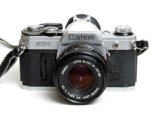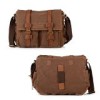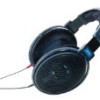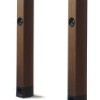Canon AE-1 35mm Film Camera w/ 50mm 1:1.8 Lens
Canon AE-1 35mm Film Camera w/ 50mm 1:1.8 Lens
- Canon AE-1 SLR 35mm Film Camera with Eye Cup
- Canon FD 50mm f/1.8 Lens
- Perfect for a student studying film photography who needs a fully manual SLR
AE-1 35mm SLR Manual Focus Camera (Chrome) with 50, , 35mm Cameras
List Price: $ 0.00
Price:
More Slr Camera Products
Similar Posts






A Classic!,
Note: If you have glasses (as I do) it may be hard to read the meter in the view finder so you have been warned.
0
Was this review helpful to you?

|An excellent vintage camera.,
The AE-1 Program stands out in photography history as one of the most widely sold SLR models, a mantle it achieved by combining excellent quality with legendary ease of use. There are exactly five controls on an AE-1 Program, plus a wizardly Program mode that automates selection of aperture and exposure length. The five controls, for the record, are (1) exposure length (the dial next to the shutter button); (2) aperture (settable on the lens body’s aperture ring); (3) ASA sensitivity (or ISO; settable on the dial under the rewind crank); (4) focus (settable with the focus ring on the lens body); and (5) exposure lock (the silver-rimmed button beside the lens mount).
Shooting the AE-1 Program is easy: hold the shutter button halfway down to turn on the meter; if you’re in Program mode, it tells you the F-stop it’ll use (to the nearest full stop), and if the yellow P is flashing, that’s a sign you need to use a tripod or find better light — the exposure length will be too long to hand-hold the camera and avoid camera shake. You can do everything manually, as I do, if you want to learn about photography in its purest form. Focus, regrettably (or happily, as the case may be), is fully manual, but with the rangefinder on the focusing screen, it’s pretty easy — source a manual for this body on the Web if you’re curious as to how it works. The viewfinder is nice and big and bright, much better than today’s digital SLRs with their tiny finders.
My example had lived in a closet for 20-odd years and worked like a charm; I was lucky in that regard. The included 50mm f/1.8 kit lens may be all the lens you ever need — I’ve captured some quite moving shots with it and expect I’ll be able to do as well in the future too. All you do is load film, focus, compose, and shoot. There are quite a few labs even in 2014 that’ll happily process your film and scan it right after it comes out of the darkroom (or minilab or what have you), so you nearly get the convenience of digital combined with the image quality only film can provide. I’ve shot Fuji and Ilford films through mine and both came out fantastic — the meter is plenty accurate enough to ensure consistent exposures as long as you can hand-hold or otherwise stabilize the camera.
If you find one in good shape, just buy it; it’s that good. There are two major known issues with the body. The first issue is that the lubricant dries up, causing an annoying squealing noise inside the body when you shoot. The best solution is to send it to a repair shop for a CLA procedure where they clean, lubricate, and adjust the camera for accurate shutter timing. The second issue is that the foam around the film door can turn to goo or dust over the years, causing light leakage. The obvious fix is to have the foam replaced or replace it yourself. The best way to keep your AE-1 Program running, though, is to use it. Just go shoot with it, and everything will stay nice and lubricated, and you’ll get the pleasure that only shooting film provides.
This camera doesn’t work without a battery, which is its only major shortcoming. It needs a 6V lithium camera battery you can find at your local drugstore or here on Amazon; look for a Duracell L28. The battery only comes on when you turn on the meter or actuate the shutter, so it lasts for a pretty long time. The FD mount became obsolete in 1986 with the release of Canon’s EOS series of auto-focus SLRs, which is good for you since it means FD lenses are plentiful and mostly cheap by way of comparison.
0
Was this review helpful to you?

|For Appreciation,
I got this camera (Canon AE-1) and it’s successor, the Canon AE-1 Program, as a gift from my parents. The cameras where the same ones they bought when the model was launched and I was surprised to see them still function perfectly easily rivaling entry level SLR’s. I’ve shot with both cameras and prefer them to my Canon digital SLR. The only real cons with shooting film is the price of film vs. the price of digital storage and the interval between taking the shot and seeing the results which is also the driving force behind the appreciation of photography as an art.
The colors produced by this camera give a soft feeling of nostalgia and the focus seems soft. The pictures look professionally taken even with the soft focus and they are sure to amaze. Buy the camera and learn on it… you might find yourself using it as a secondary camera for more “specialized” shots.
0
Was this review helpful to you?

|